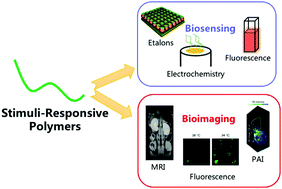Stimuli-responsive polymer-based systems for diagnostic applications
Abstract
Stimuli-responsive polymers exhibit properties that make them ideal candidates for biosensing and molecular diagnostics. Through rational design of polymer composition combined with new polymer functionalization and synthetic strategies, polymers with myriad responsivities, e.g., responses to temperature, pH, biomolecules, CO2, light, and electricity can be achieved. When these polymers are specifically designed to respond to biomarkers, stimuli-responsive devices/probes, capable of recognizing and transducing analyte signals, can be used to diagnose and treat disease. In this review, we highlight recent state-of-the-art examples of stimuli-responsive polymer-based systems for biosensing and bioimaging.

- This article is part of the themed collection: Responsive Materials for Healthcare Diagnostics


 Please wait while we load your content...
Please wait while we load your content...